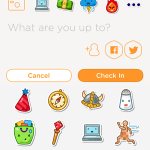
Swarm App by Foursquare Transforms Mobile Users into Influencers
In May 2014, Foursquare released Swarm, an app that allows users to check into locations and follow their friends' activities.
Familiar?
It should be. In fact, most initial reactions to the release of Swarm were that of frustration as users realized the app's functions mirrored those of the original Foursquare many had grown to love. Yet, according to International Business Insider, Foursquare's split made sense because only one in twenty consumers were using the original app for both check-ins and search. Consequently, Swarm became the product of an app unbundling process by Foursquare, similar to how Facebook unbundled its mobile into single platforms such as Messenger and Groups. So, while Foursquare focused on developing one main service: personalized, local search, Swarm became the place to check-in and follow your friends.
So, we ask ourselves, why is Swarm ranked 174th in the App Store and why are people angry about it looking exactly like the original Foursquare?
I believe that the primary reason why the app is not as popular as one would expect is that there simply is a lack of knowledge about Swarm and Foursquare's “app unbundling” process.
Let's start with Swarm’s uses:
- Check in to earn prizes and compete with friends to see who's having the best week on the leaderboard
- Try to earn the Mayor title at your favorite spots by checking in every time you visit
- Keep track of where you've been and who've you hung out with
- See who's hanging out nearby
- Send a message to your friends to make plans to meet up
Sounds fun, right? To echo the Swarm's description in the App Store, "Swarm turns every day into a game!" So even when you are eating your usual meal at your favorite local restaurant, you don't feel an overwhelming sense of ordinariness. With Swarm, you’re playing a game and, "the usual," with its feelings of stillness and bore, suddenly becomes spontaneous and full of life. To a Millennial generation of mobile users who have been described as apathetic in the past - but who have learned that emotions are the future of technology - Swarm redefines social media as a way of living, where emotions are generated through movement and gamification, instead of just being expressed or represented.
I spoke with one of Foursquare's marketing interns about why she loves Swarm. Here's what she had to say:
I like Swarm because it's fun to keep a record of the places I visit, and because I love to see where my friends are and have been. It's especially awesome when you check in somewhere and see that your friend is at a venue nearby. With Swarm, you can actually arrange a run-in with them.
Hearing this, I understood her point. And then, as though reading our mind, she added:
And of course I love it because it keeps a record of the places I've been to in my Foursquare app, as well, so that I won't forget to rate places or leave tips. I can also use Swarm to share my experience with the Foursquare community.
What I got from this explanation is that yes, Swarm is an unpopular stand-alone app, but it was specifically made to complement your Foursquare experience, not be its own thing. When you check in on Swarm, Foursquare reminds you to rate the place you visited and provide a tip. And because it is the primary means through which you check in, Swarm enhances networking among Foursquare's community of users.
However, the two diverge as a result of gamification, the main difference between Swarm and the original Foursquare. Furthermore, as Swarm users collects coins, stickers, prizes and Mayorships (previously a Foursquare feature), the more they start to represent actual capital, and in an even stranger way, the establishments they visit. So, as much as Swarm generates fun and games, winners and losers, leaders and followers, the app actually extracts value from a user's consumer experience instead of simply identifying a user’s desired location as Foursquare does with its personalized searches.
This reading of Swarm's user experience adds a branding aspect to Swarm that Foursquare lacks, where users actually become live, branded social content that people consume. In other words, Swarm is a marketing haven because it exposes users to previously unknown businesses by allowing them to create and follow a network of friends. In this way, each user is an influencer. I would go so far as to conjecture that the app's gamifying features (i.e. the leaderboard) actually drive sales and increase customer conversion rates because it makes the user want to check in and reap their rewards. Thus, in reaching previously untapped audiences, small businesses without developed social strategies could benefit from Swarm's potential for user-generated content marketing the most.
Takeaway
What I’ve learned is that the Foursquare/Swarm split wasn't just an app unbundling process, but a strategic redistribution (followed by an enhancement) of services that became exclusive to Swarm, yet continued to supplement Foursquare. All the while, Swarm was built to visually resemble the original Foursquare app, while being successful enough as a stand-alone app. And this is ultimately why Swarm is unpopular, because it's seen as Foursquare's past self, ugly sibling or fierce competitor; when in reality it's Foursquare's gamifying descendent, doing what its role model should have done for users and businesses from the start (and doing it really well), even if mobile users don’t see what I see quite yet…
This post was written by current Renegade intern Sam Oriach. You can follow him on Twitter @samoriach.


